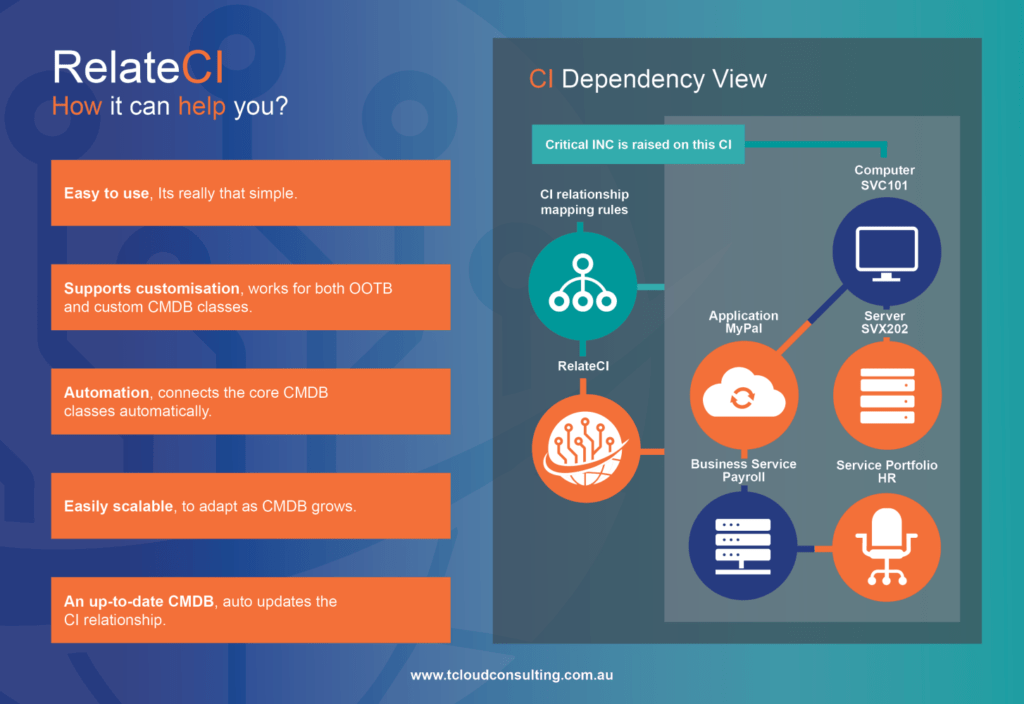RelateCI – Why do you need it?
We all know the significance of a Configuration Management Database (CMDB) in an IT organisation and the benefits of having an up-to-date functional CMDB in Asset Management, Application Management and Outage Impact Analysis.
If you are already using the ServiceNow ITSM application to manage your ITIL (Information Technology Infrastructure Library) processes, do you know that a single platform CMDB can be utilised across the ServiceNow value chain? This includes and is not limited to ITBM, GRC, DevOps, Request Management,
Test Management and many more.

Ultimately a healthy CMDB contains all the configuration items (CI) assigned to the right CMDB classes with the correct updated attributes and with the correct
CI Relationships assigned.
ServiceNow Dependency Views Map (DVM) graphically display CIs that support application or business services and the relationships between CIs created through discoverable and non-discoverable (manual) processes. It empowers organisations to be more resilient in today’s ever-changing IT landscape.
Through ServiceNow CI Dependency View, we can easily understand what CIs are communicating to one another and what their overall impact is on the organisation. With the insight of CI dependencies, we can quickly identify the impact of a server or related services due to planned maintenance, activity, or unexpected outages
To further iterate the importance of CI dependencies, below are a few questions you might ask yourself or have been asked.
- If a server goes down, which are the services or configuration items that will have an outage impact?
- If an application is not responding, which are the key business services that are affected?
- How many top critical business applications are connected to a certain server or machine currently being terminated due to a high-priority change request?
- Who are the business owners and service owners impacted due to the ongoing critical incident?
These questions have just scratched the surface of what you can answer by harnessing the power of CI dependencies.
So, all this talk about application dependencies and CI relationships, how do we create these relationships between thousands of CIs when there is no existing discovery or service mapping? especially on non-discoverable CI relationships?
There are two ways to do it:
- Manually creating these relationships, which is tedious, time-poor and error-prone.
- Use RelateCI
RelateCI is a custom application built by TCloud on the ServiceNow platform that automatically creates and updates the CI relationships between Configuration Items (CI) through predefined mapping rules.
It automates the maintenance of the non-discoverable CI relationships between CIs to minimise the manual process to create, define and delete CI relationships in DVM. Through predefined CI relationship type and its mapping rules, it automatically creates or updates the upstream and downstream CI relationships instantly which ultimately gives you a comprehensive view of both discoverable and non-discoverable CIs in a single DVM.


How Relate Helps:
- Easy to use It really is that simple
- Easily scalable to adapt as CMDB grows
- Supports custom CI classes, builds the CI relationship between out-of-the-box CMDB classes and custom CMDB CI classes
- Automation, detailed CI dependency view by connecting the core CMDB classes automatically
- An up-to-date CMDB, auto-updates the CI relationships
In this way, you will be able to maintain a scalable healthy and robust CMDB that grows with you!
TCloud has made RelateCI available free to the ServiceNow Store click here to download.

